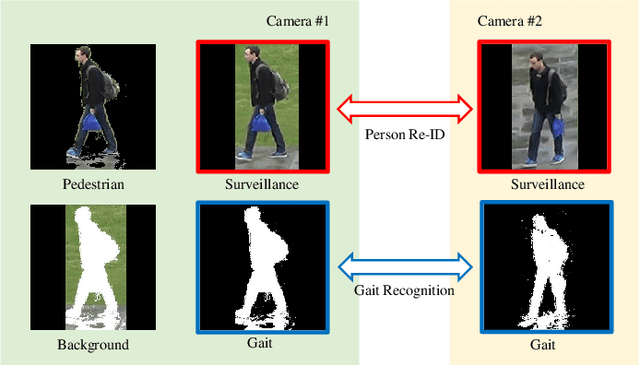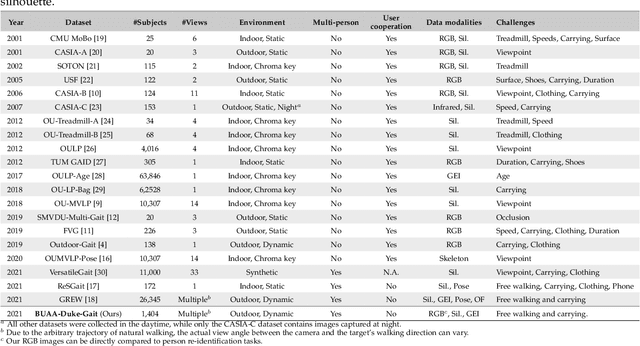Shaoxiong Zhang
GLGait: A Global-Local Temporal Receptive Field Network for Gait Recognition in the Wild
Aug 13, 2024



Abstract:Gait recognition has attracted increasing attention from academia and industry as a human recognition technology from a distance in non-intrusive ways without requiring cooperation. Although advanced methods have achieved impressive success in lab scenarios, most of them perform poorly in the wild. Recently, some Convolution Neural Networks (ConvNets) based methods have been proposed to address the issue of gait recognition in the wild. However, the temporal receptive field obtained by convolution operations is limited for long gait sequences. If directly replacing convolution blocks with visual transformer blocks, the model may not enhance a local temporal receptive field, which is important for covering a complete gait cycle. To address this issue, we design a Global-Local Temporal Receptive Field Network (GLGait). GLGait employs a Global-Local Temporal Module (GLTM) to establish a global-local temporal receptive field, which mainly consists of a Pseudo Global Temporal Self-Attention (PGTA) and a temporal convolution operation. Specifically, PGTA is used to obtain a pseudo global temporal receptive field with less memory and computation complexity compared with a multi-head self-attention (MHSA). The temporal convolution operation is used to enhance the local temporal receptive field. Besides, it can also aggregate pseudo global temporal receptive field to a true holistic temporal receptive field. Furthermore, we also propose a Center-Augmented Triplet Loss (CTL) in GLGait to reduce the intra-class distance and expand the positive samples in the training stage. Extensive experiments show that our method obtains state-of-the-art results on in-the-wild datasets, $i.e.$, Gait3D and GREW. The code is available at https://github.com/bgdpgz/GLGait.
RealGait: Gait Recognition for Person Re-Identification
Jan 13, 2022



Abstract:Human gait is considered a unique biometric identifier which can be acquired in a covert manner at a distance. However, models trained on existing public domain gait datasets which are captured in controlled scenarios lead to drastic performance decline when applied to real-world unconstrained gait data. On the other hand, video person re-identification techniques have achieved promising performance on large-scale publicly available datasets. Given the diversity of clothing characteristics, clothing cue is not reliable for person recognition in general. So, it is actually not clear why the state-of-the-art person re-identification methods work as well as they do. In this paper, we construct a new gait dataset by extracting silhouettes from an existing video person re-identification challenge which consists of 1,404 persons walking in an unconstrained manner. Based on this dataset, a consistent and comparative study between gait recognition and person re-identification can be carried out. Given that our experimental results show that current gait recognition approaches designed under data collected in controlled scenarios are inappropriate for real surveillance scenarios, we propose a novel gait recognition method, called RealGait. Our results suggest that recognizing people by their gait in real surveillance scenarios is feasible and the underlying gait pattern is probably the true reason why video person re-idenfification works in practice.
 Add to Chrome
Add to Chrome Add to Firefox
Add to Firefox Add to Edge
Add to Edge